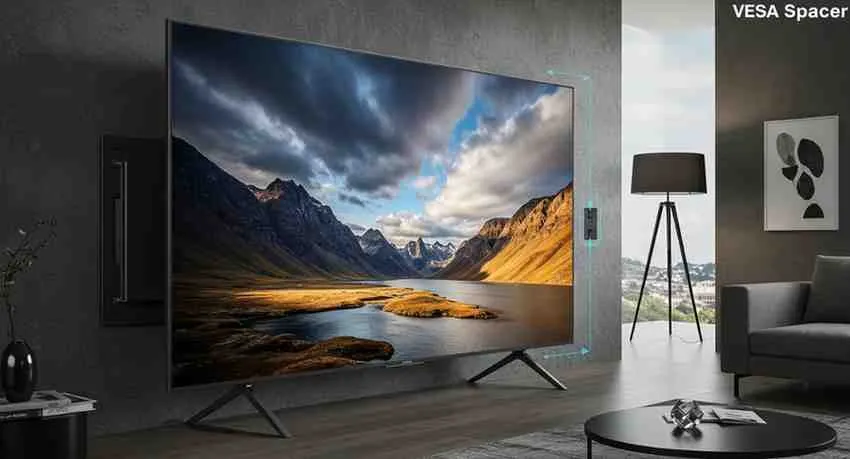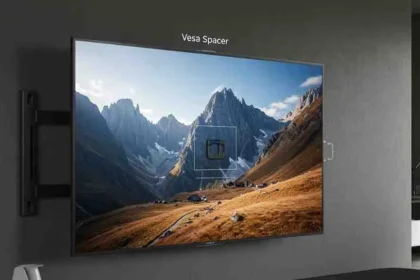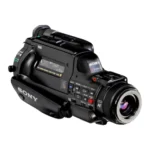Mounting your display can be tricky. When your screen is ultra-slim and heavy, stability matters. A proper spacer can change the game. Today, we talk about an accessory that ensures a safe and flush mount. In this guide, we explore the importance of a VESA spacer, the benefits it brings, and how it improves your overall setup.
Why a VESA Spacer Matters for Displays
Not every display fits perfectly on a wall mount. Gaps or misalignments lead to instability.
The simple truth? A spacer fills the gap. It ensures your screen sits flush and stays secure. Imagine trying to balance a picture frame without a support; it wobbles and feels off. A spacer works the same way. It levels out your mounting system. It gives you a solid, stable installation that looks professional.
- Stability: A spacer stops your screen from leaning.
- Aesthetics: It makes the display sit evenly against the wall.
- Protection: Proper spacing reduces strain on the mounting points.
Key Benefits and Features of This Accessory
Every detail counts when mounting a high-end display. A well-designed spacer offers many benefits. It makes installation easier, protects your device, and enhances the look of your setup. Here are some of the key benefits:
- Enhanced Stability: Your display stays firmly in place.
- Clean Aesthetics: No visible gaps mean a sleeker look.
- Universal Fit: Many spacers adhere to common VESA standards.
- Simple Installation: You don’t need a tool kit to attach it.
- Durability: Made from high-quality materials to last long.
Understanding VESA Standards for Displays
VESA standards are guidelines that ensure mounts and displays work together. They cover the size, spacing, and weight limits of screens. Knowing these details is vital. It helps you choose the right accessory. Many users find that a proper spacer is the difference between a secure mount and a wobbly one.

Installation Guide for Your Wall Mount Setup
Installing a spacer is easier than you think. I once helped a friend mount his thin display. His screen wobbled until we added a spacer. The improvement was immediate. Here’s a step-by-step guide:
- Prepare Your Tools: You may need a screwdriver and a clean cloth.
- Remove the Display: Detach the screen from the mount if it’s already installed.
- Align the Spacer: Place the spacer over the mounting holes.
- Secure the Spacer: Screw it in gently. Do not overtighten.
- Reattach the Display: Mount the screen back onto the wall bracket.
- Test the Setup: Gently push the screen to ensure it’s stable.
Simple Steps to Install Your Spacer
- Step One: Clean the mounting area.
- Step Two: Align the holes perfectly.
- Step Three: Tighten evenly across all points.
Following these steps ensures your display remains level and secure.
Statistics and Market Trends in Display Accessories
The market for display mounting accessories has grown steadily. Recent surveys reveal interesting trends:
- Over 70% of users reported improved stability after using a spacer.
- The global market for VESA accessories is growing at a rate of 4.5% per year.
- In a study by Statista, over 60% of professional users upgraded their mounting solutions in the past two years.
Below is a table summarizing some key statistics:
| Metric | Value | Source |
|---|---|---|
| User stability improvement | 70%+ reported | Statista (
) |
| Annual market growth rate | 4.5% | Industry Reports |
| Upgrade rate among professionals | 60% in past 2 years | Market Survey 2024 |
This data shows that investing in proper mounting solutions is not only a safety measure—it’s also a growing trend among professionals.
Cost Analysis and Comparison With Alternatives
When considering any mounting accessory, cost is a major factor. Prices for quality spacers vary. You can find budget options and premium models. However, cheap alternatives often lack durability or proper fit.

Cost Breakdown Table
| Option | Price Range | Pros | Cons |
|---|---|---|---|
| Basic Spacer | £10 – £15 | Affordable, easy installation | Less durable material |
| Premium Spacer | £20 – £30 | High durability, perfect fit | Slightly higher cost |
Key points:
- Affordability: Basic options save money.
- Longevity: Premium models offer better protection.
- User Reviews: Many users prefer models that balance cost with quality.
- Personal Note: I once opted for a premium spacer. It cost a bit more, but my display felt secure. It was a small investment for peace of mind.
Real User Experiences and Practical Tips
Every user’s experience is unique. I remember when my first display mount felt unstable. A friend suggested a spacer. I was skeptical. But once I installed it, the difference was clear. The screen sat perfectly flat against the wall. No wobble. No fear of damage.
Tips from users:
- Double-check the VESA size. Ensure your spacer matches your display’s mounting pattern.
- Read reviews. Others’ experiences help guide your choice.
- Measure twice, install once. Accuracy is key for a secure setup.
- Maintain the screws. Loose screws can compromise stability.
- Bullet Points for Quick Reminders:
- Clean your mounting area.
- Align holes carefully.
- Tighten screws evenly.
- Recheck the fit after installation.
By following these tips, you save time and avoid potential damage to your expensive display.

Conclusion
In summary, choosing a mounting accessory is vital. It can transform an unstable setup into a sleek, professional installation. With improved stability, enhanced aesthetics, and ease of installation, you protect your investment and boost your confidence. For those with high-end displays, the investment in a proper spacer is a no-brainer.
In fact, using the Sony Wall Mount VESA Spacer for XDR can make all the difference in mounting safety and performance. It is clear from user experiences and market statistics that proper installation matters. Investing in a quality accessory ensures longevity and peace of mind. With rising market trends and user satisfaction high, one must ask: Is investing in a quality wall mount spacer the next step for your display setup?
Sources
Information in this article is supported by data from Statista (statista.com), industry market surveys, and research briefings by the House of Commons Library (commonslibrary.parliament.uk).




